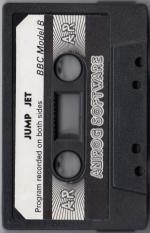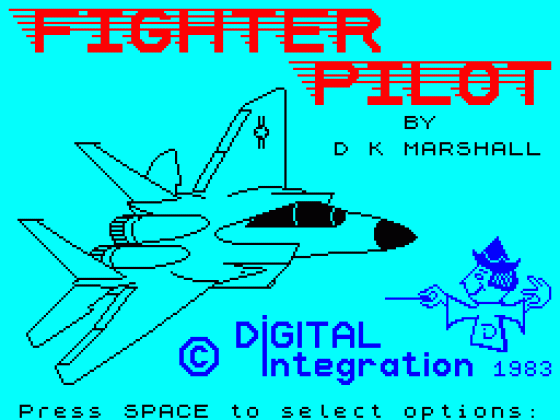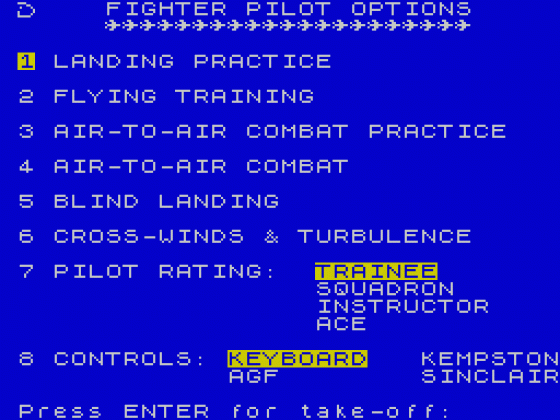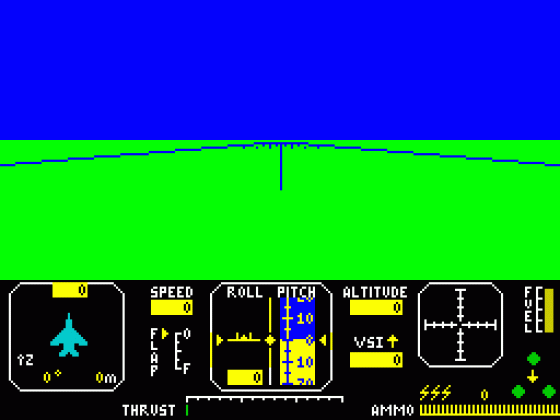Alternative Games Called Jump Jet
Available for BBC Model B
An overhead view simulator of a Sea Harrier VTOL aircraft, in which you may choose a target, engage it, destroy it and return to the aircraft carrier. Keep an eye on your fuel.
Available for Dragon 32
An overhead view simulator of a Sea Harrier VTOL aircraft, in which you may choose a target, engage it, destroy it and return to the aircraft carrier. Keep an eye on your fuel.


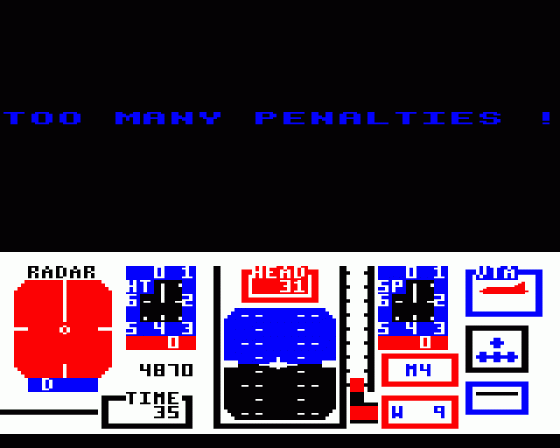
| Genre: | Game: Simulation |
| Publisher: | Anirog |
| Machine Compatibility: | BBC Model B |
| Release: | Professionally released on Cassette |
| Available For: | Amstrad CPC464, Atari 400/800/600XL/800XL/130XE, BBC/Electron, Commodore 16/Plus 4, Commodore 64, Commodore Vic 20 & Spectrum 48K |
| Compatible Emulators: | BeebEm (PC (Windows)) PcBBC (PC (MS-DOS)) Model B Emulator (PC (Windows)) |
| Original Release Date: | 1st January 1986 |
| Original Release Price: | Unknown |
| Market Valuation: | £2.50 (How Is This Calculated?) |
| Item Weight: | 64g |
| Box Type: | Cassette Single Plastic Clear |
| Author(s): | Vaughan Dow |
Variant Items
There are 5 other items featuring this same game (that we know about!). Click any of them for their details.
Active Auctions
Closed Auctions
Buy It
Unfortunately no-one is currently selling this item.
Auction Price Watch
Worried you're being ripped off? Closing prices on eBay can help you decide what a reasonable price is for a particular item.

Acorn User
1st January 1986
Beware, this is a joystick-only game... Flying and manoeuvring are difficult and you are penalised for each mistake you make. Read Review

Home Computing Weekly
4th June 1985
A jump in the right direction for Anirog. Read Review
Full Instructions
Jump Jet
Every pilot has the dream of flying one of these unique and complex fighting machines. Here is your chance to do what few pilots have the privilege to try.
Depending on your skill, confidence and courage, you have the choice of remaining near the landing pad, learning to hover and land, or venturing higher to practise your approaches. When you think you have mastered these, then accelerate the Jump Jet into an attack fighter. Use the radar and range finder to seek and destroy the enemy, by launching heat-seeking air-to-air missiles. Beware! His radar and missile systems are as good as yours. Reckless pursuit is ill-advised: you must maintain a fuel level that will enable you to relocate and return to the aircraft carrier, executing the skills you have learned to achieve a successful landing.
You are now ready to proceed to the next skill level to face additional hazards, such as unpredictable swell and treacherous cross-winds.
Be warned, this program is not a toy or game. You will need to co-ordinate your hands, eyes and mind to successfully complete each mission. Do not hope to achieve in a short time that which took the author three years to learn as a Jump Jet pilot, and over a year to record on this computer program.
"Jump Jet" is a common name given to aircraft that do not require a runway in order to become airborne.
This computer program contains the essential elements of a mission undertaken by a Jump Jet from the deck of an aircraft carrier and gives the user the following options:
- Taking off and hovering over the landing pad
- Flying a little higher, hovering over the carrier, and learning to position the aircraft over the pad in preparation for a vertical landing
- Leaving the vicinity of the carrier to practise approaches
- Accelerating away to track down and destroy enemy aircraft, then returning to land.
Successfully landing the Jump Jet requires considerable skills. This aspect of the mission should be practised until it can be accomplished without using too much fuel; only then should the pilot attempt to leave the vicinity of the carrier in search of the enemy. It is comparatively easy to leave the carrier from take-off, but if the pilot is unable to approach and land, the mission will have failed and no promotion will be gained.
A Sea Harrier fully laden with 6,600 pounds of fuel and its full complement of armaments (missiles and bombs) has to use a ski-runway at the end of the carrier to become airborne. This program has been specifically modified to carry only 5,000 pounds of fuel and four missiles. A hover take-off is therefore possible and adds greatly to the user's interest. All distances are given in nautical miles and speed is given in knots (nautical miles/hour).
The program has four skill levels and a practice level, any of which can be selected at the start of the program. The pilot starting as a Flight Lieutentant (Skill Level 2) progresses through the ranks of Squadron Leader and Wing Commander to Group captain (Skill Level 5). Considerable skills are required to land a Jump Jet in stormy conditions and mountainous seas. On Practice Level (Skill Level 1) the plane will be re-fuelled each time that you land on the pad.
Although it is impossible to incorporate every aspect of this fighter plane into a computer program with limited memory, the program does contain the features that make this aircraft unique.
Flight Theory
On a conventional jet aircraft with fixed rearward pointing jets increased thrust results in increased speed. Since lift is provided by the wings, the aircraft has to reach a certain speed to provide enough lift for it to become airborne, and once airborne the aircraft must maintain speed to avoid stalling. The plane's attitude in flight is controlled by normal wing (Ailerons) and tail (Tail Plane) adjustments.
However, the Jump Jet has the ability to alter the angle of its jet nozzles. Only when the aircraft is flying in excess of 180 knots with the nozzles pointed rearwards will the Jump Jet behave like a conventional jet aircraft, and react normally to speed and attitude control.
Lift is provided by pointing the nozzles down or at an angle. When the nozzles are pointing vertically down an increase in thrust results in increased height. At this stage pulling back on the joystick will cause the aircraft nose to tilt up; this will make the plane fly backwards. This characteristic is used to position the plane accurately above the landing pad when in hover mode. However, the manoeuvre described above could cause a loss of height; this should be corrected by accurate control of thrust.
When the nozzles are pointing at an angle the vertical vector of the thrust provides lift, and the horizontal vector provides forward movement. Therefore, to accelerate from hover position the thrust is set to an angle of 45 degrees. At low speeds, the normal attitude controls (Ailerons and Tail Plane) are relatively ineffective. The control valves divert a measure of thrust to small jets called "puffers", which are situated at the nose, tail and wing tips. The puffers are controlled, as in normal flight, by the joystick; raising the nose at this stage will slow the plane, eventually causing it to fly backwards; while dipping the nose will increase the speed. The nozzles can be set rearwards when the speed has reached in excess of 180 knots. The Jet now behaves as a normal plane.
When the Jump Jet is travelling at high speeds, the thrust can be pointed forwards to achieve rapid deceleration. When decelerating, the nozzles must first be changed to the vertical or 45 degrees position before the air speed falls below 180 knots, in order to maintain lift and prevent stalling.
What You Can Expect To See
The instrument panel will be in view throughout the program action, and at all times the action viewed through the cockpit window reflects the readings currently displayed on the instrument panel.
The initial display is a bird's-eye view of the Jump Jet, positioned on an aircraft carrier.
As the Jump Jet lifts off and gains height, the shadow of the aircraft will shrink, representing the increasing distance above the landing pad. Once above 50ft, the view will change to a split screen; the left showing the side view, and the right showing the rear view of the carrier. If the Jump Jet is then positioned exactly over the pad and the height decreased to less than 30ft, the scene will revert to the opening bird's-eye perspective. However, if the Jump Jet is flown higher than 200ft, or moves out of range of the split screen, then the view will change to that seen from the cockpit, as the Jet is flown over the sea past clouds and waves, whose relative positions react realistically to the forward and turning motions of the aircraft. When returning to the carrier using the radar navigation, the pilot can first expect to see the carrier appear on the horizon, moving closer as the aircraft approaches. Provided that the approach to the carrier is performed correctly, the scene will return to the split screen view of the carrier and plane, and subsequently to the bird's-eye view.
Instrument Panel And Controls
-
Radar
After the pilot has left the carrier and is out at sea the radar will show the relative positions of the carrier (ship symbol) and the enemy aircraft (triangle). The vertical line on the radar scanner represents the direction of flight of the aircraft with the Jump Jet at the centre circle. Therefore, to directly approach a target, the Jet should be turned until the desired target lies under the line. The distance of the target from the centre circle represents the actual distance of the pilot from the enemy aircraft or carrier: the outer edge of the radar screen represents approximately 28 miles. -
Radar Distance Lock
If key 'R' is pressed during the flight, an aiming sight will appear on the radar which can then be controlled by the joystick. By accurately positioning the sight over the carrier or enemy, pressing the fire button will display the exact distance between you and the target. The appropriate target will flash on the radar until deselected by the pilot by a further press of key 'R'. While the joystick is used to control the radar lock, the Jet will continue in the direction set before 'R' was pressed; so select the target quickly. The distance at 2 may show a distance greater than 28 miles if the target is on the edge of the radar, in which case the radar position represents the last-known position of that target before it left the radar cover area.
If a fix on the carrier is taken before pursuing the enemy, its distance from the pilot will continue to appear in window 2, although the carrier is outside the radar cover area. This facility is essential to locate the carrier. - Altitude
- Altitude
The pointer represents tens, hundreds, or thousands of feet (as appropriate). The window at 4 shows the exact altitude to the nearest foot. -
Fuel
The initial fuel load shows 5,000 pounds. The fuel loads does not affect your speed or performance, in any significant way. -
Time
This shows the length of flight. The skilled pilot will use this indicator to assist in fuel and navigational calculations. -
HDG
This shows the compass heading of the Jump Jet, between 0 and 360 degrees. This heading will change if the aircraft is turned. -
Artificial Horizon
This shows the relative position, in terms of pitch and bank, of the aircraft to the outside horizon. It does not indicate height. Levels of pitch and bank are controlled by the joystick, in the normal way. -
Power
A thermometer scale of nine divisions shows the power selected by using + and - keys. Approximately 75% of available power is required to maintain height when hovering steadily, whilst full power is necessary to climb or accelerate away. -
Warning Light
The warning light, accompanied by an audio signal, if any of the following conditions exist:
- The fuel level falls below 300 lbs;
- The height is greater than 500ft;
- The undercarriage is not down while the Jet is on the carrier;
- The flaps are not down on take-off or landing;
- You approach the carrier with gunsights on;
- Your speed is less than 180 knots and the nozzles are directed rearwards;
- Either the undercarriage or flaps or both are still down at a speed greater than 300 knots.
-
Number Of Warnings Accumulated Per Flight
If you exceed the number of warnings allocated for each level you will not achieve a higher rank.
Level Rank Warnings Allowed 1 Practice Level - 2 Flight Lieutenant 9 3 Squadron Leader 7 4 Wing Commander 5 5 Group Captain 3 - Airspeed
- Airspeed
The pointer shows airspeed to the nearest 10 or 100 knots with the exact speed shown in window 13. Negative speeds (rearward flight) are shown only in window 13. -
Missiles
The number of air-to-air missiles remaining is displayed at 14. The aiming sight is selected by key 'M'. Each flight is allowed 4 missiles. -
VTA
This shows the angle of vertical thrust, as selected by:
Key 1 - Rearward thrust Key 2 - 45 degree thrust Key 3 - Vertical thrust Key 4 - Forward thrust -
Undercarriage
The undercarriage position, down (green) or up (red) is controlled by the key 'U' on the keyboard. It should be up before the Jet exceeds 300 knots, to avoid adding a warning to the total. The undercarriage can be lowered when the speed is less than 300 knots. -
Flap Position
Flap position, either up or down, is selected by the 'F' key. Flaps must be down before you apply vertical thrust, to start hovering. Flaps must be up before exceeding 300 knots and down before the speed falls below 180 knots.
Take Off
To take off, it is necessary to select flaps down - (F) vertical thrust - (3) and increase power to maximum - (+)
Hovering: Scene 1
Once airborne, reducing power to 3/4s of maximum will maintain height. Forward and backward movement is controlled by using the joystick. Banking the Jet will induce sideways movement. Manoeuvering causes loss of height so more power may be required.
Hovering Over The Carrier: Scene 2
If the height has been increased to more than 50ft, the scene through the cockpit window changes from the bird's-eye view to the split screen perspective, but control of the Jump Jet remains the same. If the plane is not positioned exactly over the landing pad before attempting to come below 20ft, a warning will sound. If positioned correctly, the scene will change to a bird's-eye view, once below 30ft. Therefore, if you are below 30ft, and the scene has not changed, do not come any lower. Increase height and reposition the aircraft accurately over the landing pad.
Landing
To land on the pad, manoeuvre the aircraft over the centre of the pad and reduce the power (in order to reduce height). At higher skill levels, wind and rising seas will necessitate landing with speed, to give zero movement in relation to the carrier.
Acceleration
If the Jump Jet is flown higher than 200ft, or manoeuvered out of range of the split screen display, the scene will change to a sea and sky environment and the radar will show the relative positions of the carrier and enemy aircraft. By selecting thrust at 45 degrees, the aircraft may be accelerated to normal flying speed. Remember that you should not select rearward thrust until a speed of at least 180 knots is attained, and that you should raise the undercarriage and flaps before exceeding 300 knots to avoid gaining warnings.
Flight Over The Sea
A speed of approximately 400 knots is required to achieve economical low-level cruising. Prolonged high power settings will consume too much fuel.. If you climb to 5,000ft or above you will be exposed to enemy radar, and missile attack (and collect warnings).
Enemy Attack
Select 'M' to activate the aiming sight and arm the missiles. Turn the Jump Jet to bring the enemy aircraft on to the line of radar. When you are within five miles of the enemy, the screen will change; the enemy will disappear from the radar and appear within the pilot's view. At this point you have no option to disengage, but must fight or be destroyed. Once sighted, then manoeuvre the Jet to bring the enemy aircraft in line with the aiming sight; do not release the missile unless some part of the enemy's plane is within the sight. You must fire accurately before you close within 2 miles of the enemy or you will be destroyed. The exact distance of the Jet from its target can be monitored by using the radar lock. When one enemy aircraft is destroyed, another will appear on radar. You have the option to give pursuit or return to the carrier.
Navigation
Keep an eye on your fuel reserves and use the radar to gauge your distance from the carrier. The radar may, in fact, be showing the last known position, if the carrier has moved outside radar range. You may need to relocate the carrier by initiating a "square search". This is done by flying in one direction for a while, then changing direction until you find the distance between the Jet and carrier decreasing. For example, suppose the carrier position is 4 o'clock and is outside the radar cover area; flying in the 6 o'clock direction will reduce the distance, and this will be confirmed by the reading displayed in window 2. The rate of decrease will be slower than if the selected direction had been 4 o'clock. A skilled pilot will see the correlation between the rate of decrease, air speed and time.
Returning To Land
Once the carrier has been located on the radar you must approach it until it appears on the horizon at 5 miles' distance, at which time the radar becomes ineffective and the approach is controlled visually. You must be within 2 miles, between 50 and 200ft high, and travelling at less than 20 knots to achieve the close-up landing scene, and once again be exactly over the pad below 30ft, before the Jump Jet is placed in the final landing scene.
Skill Levels
There are five skill levels. The skill level is selected at the start of the program. Your rank is denoted by the skill level selected and successful completion of the subsequent mission. As you progress through the ranks, you must destroy a greater number of enemy aircraft and face worsening climatic conditions.
| Level | Rank | Weather Conditions | Enemy Aircraft |
| 1 | Practice level | Calm | - |
| 2 | Flight Ltnt. | Calm | 1 |
| 3 | Squad. Leader | Fresh | 2 |
| 4 | Wing Commander | Turbulent | 3 |
| 5 | Group Captain | Stormy | 4 |
You must successfully complete the mission to attain the selected rank. Promotion through the ranks requires increasing skill in hovering, altitude and attitude control. In particular, the effects of wind on the Jump Jet, and sea on the carrier require considerable skills when approaching the carrier and in achieving a successful landing.
Loading
Tape: CHAIN"" (RETURN)
Disc: SHIFT-BREAK
Screen Designers
The following utilities are also available to allow you to edit the supplied screens of this game:
Cheats
Download
A digital version of this item can be downloaded right here at Everygamegoing (All our downloads are in .zip format).
| Download | What It Contains |
|---|---|
| A digital version of Jump Jet suitable for BeebEm (PC (Windows)), PcBBC (PC (MS-DOS)), Model B Emulator (PC (Windows)) |
Games Like Jump Jet
Report A Problem
We thank you from the bottom of our hearts if you report something wrong on our site. It's the only way we can fix any problems!
You are not currently logged in so your report will be anonymous.
Add Note
Release Country
Change the country to update it. Click outside of this pop-up to cancel.
Scan Of Selected Article
If you auction an item, it will no longer show in the regular shop section of the site.

